Lady Gaga, a name synonymous with boundary-pushing pop and visual extravagance, often polarizes opinions. While some may find her pop music, as the original article suggests, to be momentarily enjoyable yet ultimately “vapid,” dismissing her as merely fame-hungry overlooks a crucial aspect of her artistry. Gaga has transcended the label of a simple singer-songwriter; she has become a visual artist par excellence. Her songwriting and singing abilities, while prolific, are arguably overshadowed by her masterful command of visual performance and storytelling. To truly grasp this, one needs to delve into her visual works, particularly “Telephone,” directed by the visionary Jonas Akerlund, her collaborator on the iconic “Paparazzi” video. This video isn’t just a standalone piece; it’s intricately connected to “Paparazzi,” building a universe of visual references and solidifying Gaga’s position as a performance artist who leaves her Heart On The Dance Floor, even if that dance floor is a prison yard, a diner, or the vast desert.
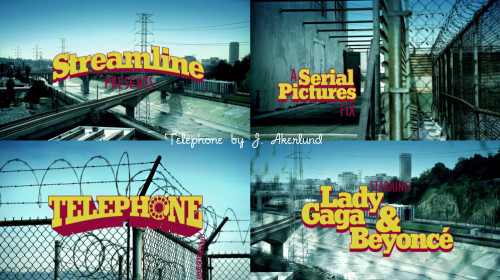
“Telephone” cleverly picks up where “Paparazzi” left off, commencing with Gaga’s character’s arrest for poisoning her boyfriend. The initial scenes unfold within a “jail for bitches,” immediately setting a tone of rebellious femininity and cinematic homage. The opening credits, splashed in yellow, pink, and red – a color palette that will recur throughout the video – are the first of many nods to the world of cinema. The most immediate reference is Jonathan Demme’s 1974 film, Caged Heat, a story centered around women in a sexually charged prison environment, mirroring the atmosphere Akerlund establishes.
Gaga’s arrival at the prison is orchestrated by two blonde female officers, their uniforms playfully subverted – shirts unbuttoned, bras boldly displayed – a clear tribute to the bombshell aesthetics prevalent in Russ Meyer’s films. This visual language sets the stage for the entire prison sequence: inmates are not depicted as hardened criminals but rather as figures plucked from a high-fashion, edgy photoshoot, all strikingly beautiful, tattooed, and scantily clad.
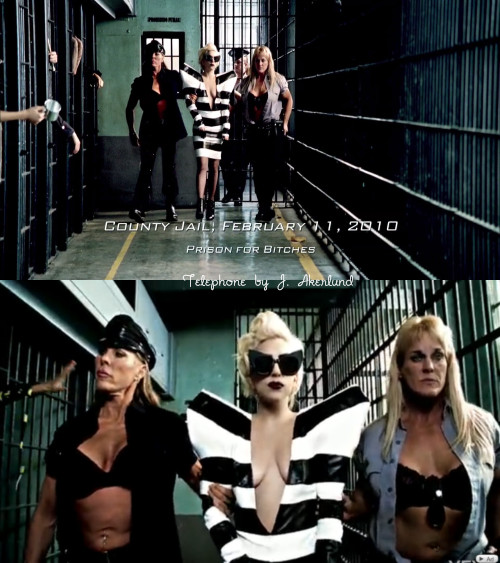
Gaga’s entrance outfit, a low-cut dress with dramatically exaggerated shoulders, custom-designed by Jean-Charles de Castelbajac, cleverly evokes the stereotypical black and white striped prison uniform. Her platinum blonde hair is styled in a voluminous, curly updo, while her eyes are shielded by Mercura butterfly-winged sunglasses, adding to the theatricality.
The moment the officers remove Gaga’s dress upon arrival at her cell door is reminiscent of a scene in “Bad Romance,” where she is similarly stripped and seemingly forced to consume vodka (or perhaps water). This recurring motif of forced vulnerability and stripping away layers is a signature element in Gaga’s visual narratives, highlighting her performance of vulnerability even within hyper-stylized contexts.
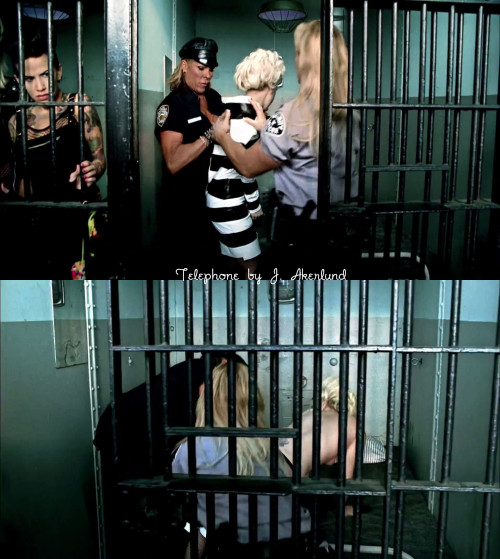
However, the overall tone of “Telephone” diverges significantly from the darker, more overtly sexualized “Bad Romance.” In “Telephone,” the partial nudity serves a different purpose: the officers’ action is framed as a measure to ascertain whether Gaga is a hermaphrodite, a bizarre and unsubstantiated rumor that circulated at the time. True to Gaga’s video style, narrative coherence sometimes takes a backseat to visual spectacle, and certain scenes seem primarily designed to showcase elaborate costume changes and push visual boundaries.
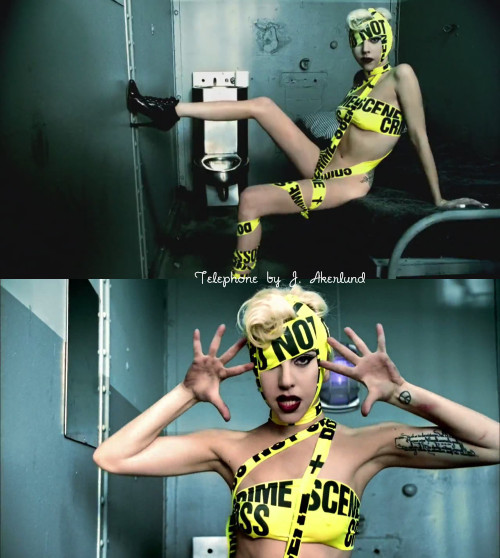
One such outfit is the crime scene tape ensemble, custom-made by Brian Lichtenberg. While the original article deems it “tacky,” it undeniably contributes to the video’s overall aesthetic of provocative and unconventional fashion. Gaga’s consistent fascination with obscuring her eyes is again evident, this time with a crime scene tape headpiece partially veiling her face. This act of concealment adds an element of mystery and reinforces her persona as a performer who uses visual artifice to construct her identity.
The subsequent scene shifts to the prison yard, a quintessential setting in countless prison films, often serving as a backdrop for violence or confrontation. Similar to these cinematic tropes, Gaga’s arrival in the yard is met with attention, though not necessarily aggression.
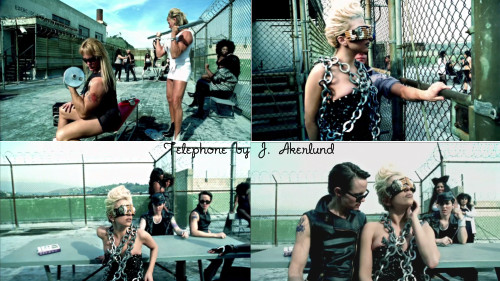
The yard is populated by inmates in stark black and white attire: some engage in exercise (including two blondes reminiscent of the officers), others listen to music on a boombox, and many are simply captivated by Gaga’s outlandish appearance. She sports a jumpsuit adorned with chains (a Viktor & Rolf creation) and sunglasses shaped like smoking cigarettes. These “disturbing smoking cigarette sunglasses,” as described in the original text, follow in the footsteps of the razor-blade glasses from “Bad Romance” in their shock value and deliberate tastelessness, challenging conventional notions of beauty and style. Instead of facing violence, Gaga engages in a passionate kiss with an androgynous inmate, further blurring gender lines and defying expectations.
The video transitions back indoors to a prison community room, where Gaga is positioned next to a brunette who bears a striking resemblance to her.
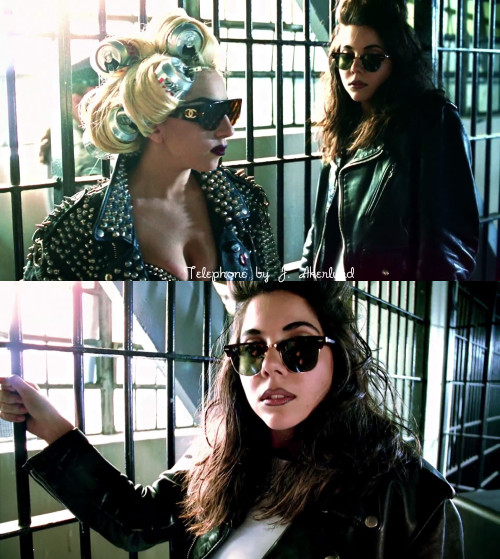
This is Natali Germanotta, Gaga’s younger sister, marking her screen debut. Both sisters are wearing sunglasses – Gaga in vintage Chanel, and Natali in Ray-Ban Clubmasters. Natali’s styling, featuring a plain white tee, black leather biker jacket, dark lip liner, and a lighter lipstick, suggests a “chola” aesthetic within the video’s diverse visual tapestry. While a catfight erupts between two other inmates, Gaga nonchalantly answers a phone call, her hair playfully styled with Diet Coke cans as rollers – a testament to her resourcefulness and quirky charm.

Her studded black leather jacket, by Search & Destroy, features a Doom patch, a nod to the British crust punk band, showcasing Gaga’s eclectic influences. Her makeup in this scene is particularly striking, with heavy eyeliner and dark crimson lips creating a dramatic and powerful look.
Despite not being a “natural-born dancer” according to the original article’s assessment, Gaga’s videos invariably feature dance routines. In “Telephone,” she performs a dance sequence with four fellow inmates in the prison aisle. This scene is a clear homage to the “Cell Block Tango” from the musical Chicago, further cementing the video’s cinematic inspirations.
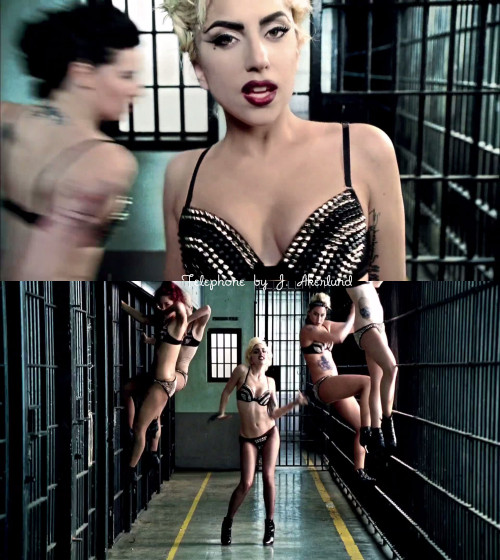
The embellished bras and panties worn by Gaga and her dancers are creations of Haus of Gaga, highlighting the in-house creative force behind her visual world.
Lady Gaga’s character is then released on bail, making her exit from prison in typically dramatic fashion. She dons a striking ensemble: a large hat, gloves covering only four fingers, and round sunglasses.
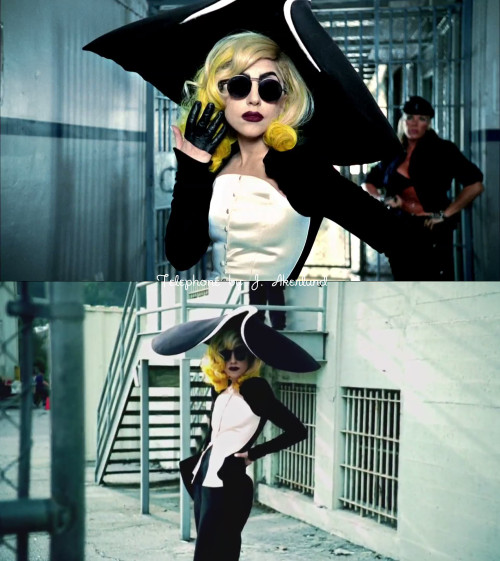
Her hair now features bright yellow highlights, contrasting with the platinum blonde. The black and white suit and hat are both vintage Thierry Mugler pieces, underscoring the video’s high-fashion sensibilities and Gaga’s penchant for vintage couture.
The narrative introduces the second protagonist, Beyoncé, who has posted Gaga’s bail. Their first encounter occurs in a van, with Beyoncé behind the wheel, playfully scolding Gaga with the now-iconic line, “You’ve been a very bad girl, a very very bad bad girl, GaGa.” As they drive away from the prison, Gaga playfully snaps Polaroids of Beyoncé and throws them out the window, capturing their carefree rebellion.

The collaboration between Gaga and Beyoncé is lauded in the original article as surprisingly effective, bridging two distinct musical worlds. Beyoncé’s presence is particularly praised for her captivating sex appeal and undeniable star power, even in scenes where she’s not overtly revealing. Her ability to command attention alongside Lady Gaga is emphasized, referencing their previous collaboration in Beyoncé’s “Video Phone,” where Beyoncé was considered magnificent while Gaga was deemed “vapid.” This dynamic sets up an intriguing interplay between the two pop icons.
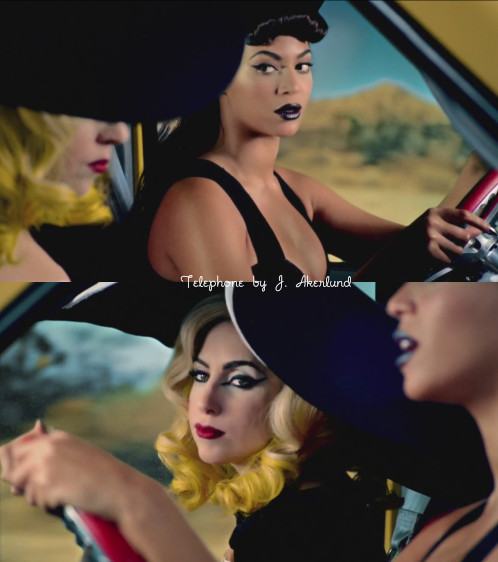
Beyoncé’s vintage hat and bra are also Thierry Mugler, solidifying the designer’s significant influence on the video’s fashion direction.
A stop at a diner reveals their vehicle to be the iconic “Pussy Wagon” from Kill Bill Vol. 1. Quentin Tarantino’s involvement in the video’s concept is highlighted, revealing that he suggested the use of the memorable car.
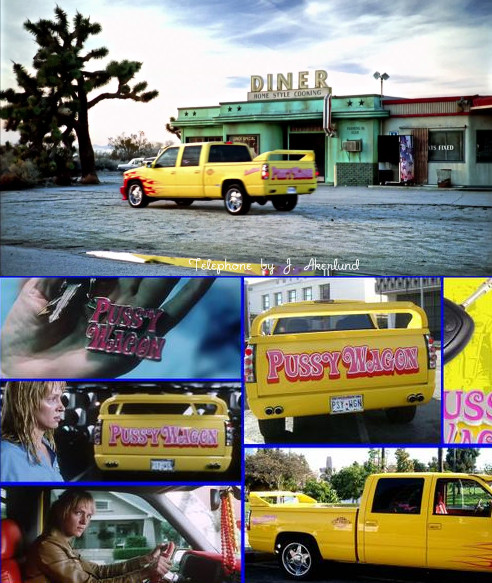
The “Pussy Wagon,” adorned in yellow with pink and red accents (echoing the opening credits’ color scheme), becomes another Tarantino reference point in this visually rich short film. The diner stop sets the stage for a dramatic revenge plot. Beyoncé’s character confronts her boyfriend (played by Tyrese Gibson) and poisons him, presumably for infidelity, initiating a sequence of escalating violence.

Beyoncé enters the diner in a yellow latex bustier dress by Atsuko Kudo, paired with Jeremy Scott for Linda Farrow Mickey Mouse sunglasses.

These Mickey Mouse sunglasses create a direct visual link to “Paparazzi,” where Gaga wore them in a similar poisoning scene, establishing a recurring motif of playful yet deadly femme fatale imagery.

Beyoncé’s makeup in this scene is lauded for its “cat’s eye” elegance and stylish short bangs. Even her nail art, featuring the American flag, is noted for its unexpected charm, despite the original author’s general dislike for nail art.
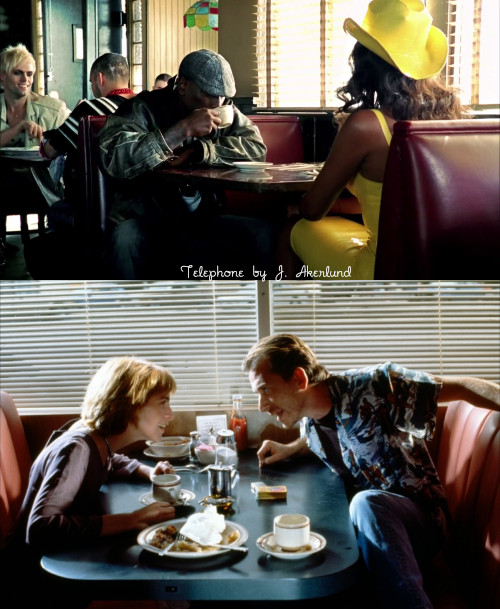
The diner setting and the impending violence draw a parallel to another Tarantino masterpiece, Pulp Fiction, specifically the film’s iconic opening scene set in a diner where Honey Bunny and Pumpkin plan a robbery.
While Beyoncé handles her boyfriend, Gaga takes charge in the kitchen, preparing poisoned food for all the diner patrons. This sequence, titled “Let’s make a sandwich,” incorporates a brief dance routine, injecting a touch of dark humor into the unfolding massacre.
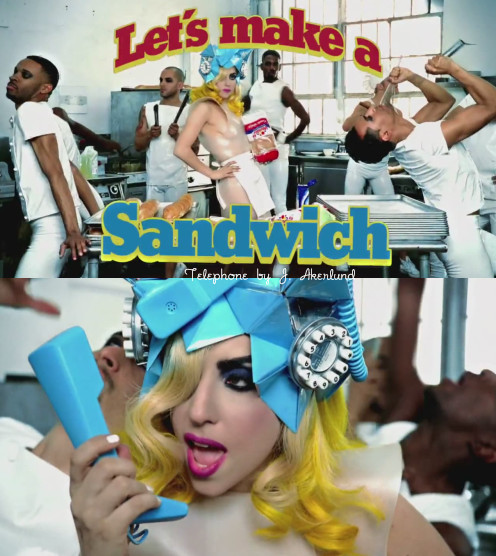
Gaga wears a rubber dress by Rachel Barrett (previously seen in the bathtub scene in “Bad Romance”) and an extravagant telephone headpiece by Fred Butler. Her makeup is again highlighted, particularly the blue eyeshadow contrasting with fuchsia pink lips. Her nails are painted with OPI Alpine Snow nail polish.

The “Cook’n’Kill” ingredients are playfully listed, drawing from science fiction and technology references: Rat Poison, Meta-Cyanide, Fex-M3, and Tiberium, adding a layer of pop-culture geekiness to the deadly concoction.
The poison successfully eliminates all the diner customers, but the protagonists remain unfazed, celebrating their crime with another dance routine. This scene is notable for Gaga and Beyoncé’s outfits, which pay homage to the American flag, albeit in distinct styles.

Gaga’s two-piece costume, by Haus of Gaga, paired with Christian Louboutin Supra Fifre over-the-knee silver boots, is contrasted with Beyoncé’s frilly short dress by Oscar Olima, which shares the color scheme of Captain America’s costume. The original article criticizes Gaga’s styling in this scene, deeming her costume “hideous” and the bandana reminiscent of Axl Rose, finding it less appealing than Beyoncé’s look.
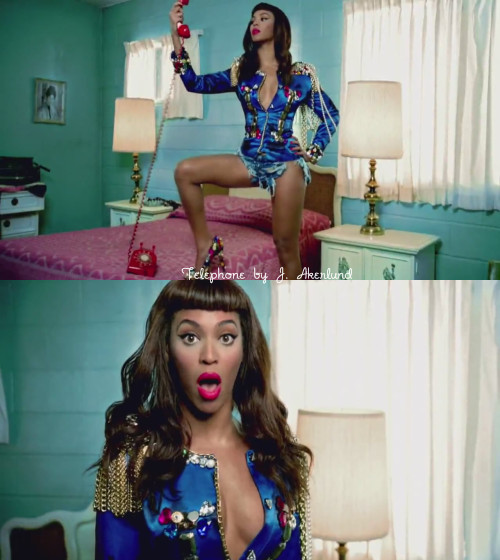
Subsequent scenes are described as “fillers.” One features Beyoncé yelling into a phone in a motel room, wearing a Jean-Charles de Castelbajac embellished military jacket, ripped denim shorts, and pumps.
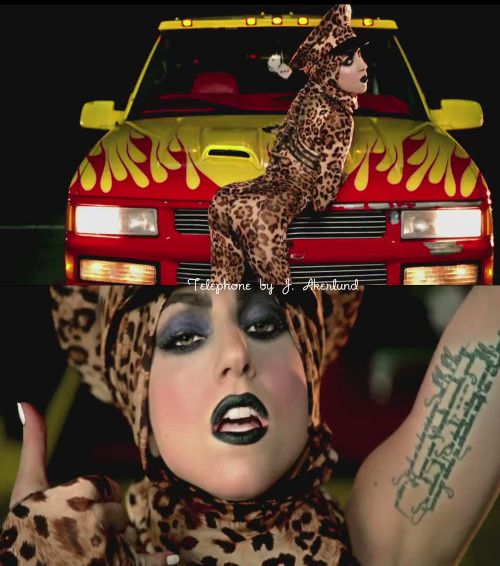
Another scene depicts Gaga dancing (or “sort of dancing”) in front of the Pussy Wagon, clad in a leopard jumpsuit and hat, both Haus of Gaga designs. Her makeup features heavy smokey eyes and black matte lips, a combination deemed less appealing by the original author. The leopard print is suggested to be a possible reference to Shania Twain’s “That Don’t Impress Me Much” video, connecting to the recurring theme of female strength and independence.
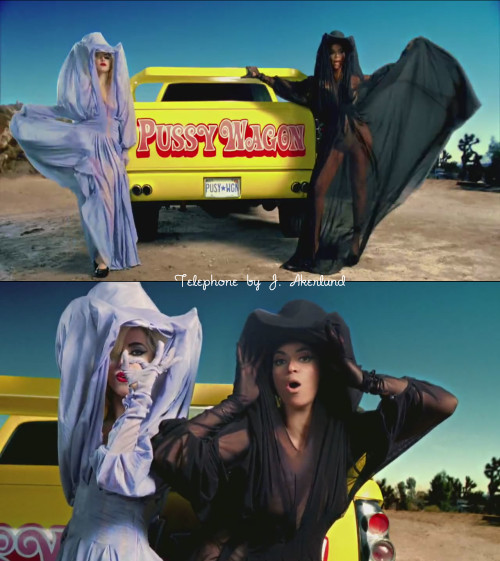
The final scene, considered the “favorite,” is set in the desert. Gaga and Beyoncé dance in front of the Pussy Wagon before driving off. Their outfits – sheer dresses and veiled cowboy hats – are by Emilie Pirlot. Beyoncé is praised for her sex appeal even when fully covered, while Gaga’s lavender dress is seen as washing her out. The western aesthetic evokes references to Brigitte Bardot movies like Viva Maria! and Les pétroleuses, both featuring independent and non-conformist female protagonists.

The desert setting, combined with the Pussy Wagon and framing, reinforces the idea of escape and leaving the scene of the crime behind.

The singers’ makeup in the desert scene is described as “flawless,” with perfect cat-eye eyeliner.
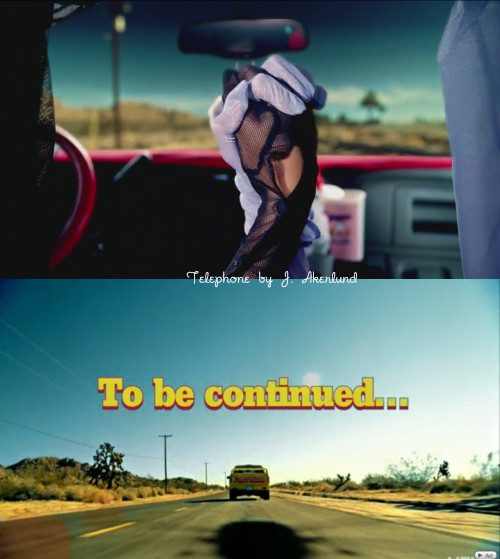
The video concludes with Gaga and Beyoncé holding hands, symbolizing their pact to escape and never return, drawing a parallel to Thelma & Louise. The closing title card promises “To be continued…,” hinting at future visual installments in Gaga’s cinematic universe, ideally in collaboration with Jonas Akerlund.
[1] Mugler was Beyoncé’s creative advisor for her 2009 world tour and designed all her costumes.
[2] The name of the vehicle is a reference to Grease, because it comes from the lyrics of the song Greased Lightning.
[3] These movies have been sources of inspirations to Bandidas (2006) by Joachim Rønning and Espen Sandberg, starring Penelope Cruz and Salma Hayek.
